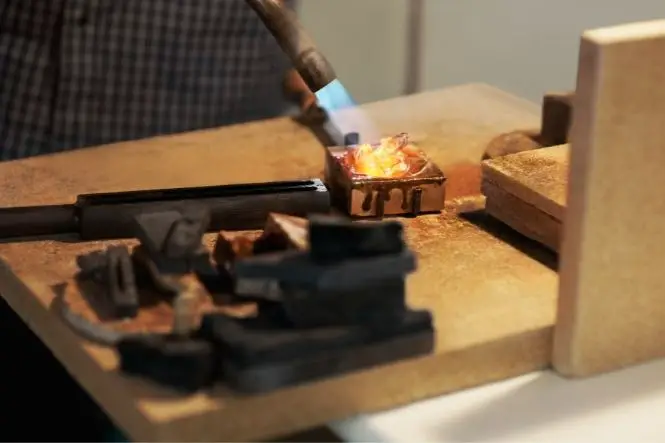Different solids turn into liquids (melt) at different temperatures. This temperature is described as the melting point. Some solids are made up of molecules that bind together tightly and others are made up of molecules that bind together loosely – the tighter the binding, the higher the temperature needed to make them melt.
Table of Contents
Melting Points
Pure solids that are made up of only one type of molecule (such as a block of iron – melting point 1536 °C) always melt at the same temperature. Solids that are mixtures of different types of molecules (such as a block of steel, which is a mixture of carbon and iron, melting point from 1425 °C) tend to melt at a lower temperature.
Knowing that pure solids have fixed melting points, and that impurities will lower the melting points, the temperature at which something melts can be used to identify unknown solids, or test whether they are pure.
As well as melting points, elements also have boiling points, where the liquid turns into a gas. Some solids don’t melt, they ‘sublime’- turn straight from a liquid to a gas. Examples of this include solid carbon dioxide (dry ice), carbon and iodine.
Of all the elements, tungsten has the highest melting point, at 3422 °C. Carbon is sometimes listed as having a higher melting point, at 4027-4427 °C, but it actually sublimes at 3727 °C. These temperatures are a bit high for testing at home, though!
Testing For Melting Points
Some of these experiments use boiling water and butter, wax and chocolate are all hot when melted. Please be very careful when around hot liquids – use oven gloves to handle hot pans and bowls, don’t splash or spill the liquids over yourself, and if you do, cool any burns with plenty of cold water.
Chocolate
Break up some squares of chocolate and put them in a bowl over a pan of boiling water, or gently heat the bowl in the microwave. If using the microwave, set it on low and heat the chocolate in ten or twenty second bursts.
Keep stirring and checking the temperature of the chocolate as it melts – is the temperature any different with cheap chocolate or expensive chocolate? What about with dark chocolate, white chocolate or milk chocolate?
Don’t waste the melted chocolate – mix in breakfast cereal or broken biscuits and dried fruit and let it set in the fridge to make home-made chocolate bars.
Butter
Chop up butter into cubes and put in a bowl over a pan of boiling water, or gently heat the bowl in the microwave on low, but in five or ten second bursts. Keep stirring and checking the temperature of the butter as it melts – is the temperature any different with butter or margarine? What about low fat and ordinary margarine?
Don’t waste the melted butter – get some oats, syrup and dried fruit, and make some flapjacks.
What Happens?
Chocolate’s melting point is at about 36 °C, which is around the normal body temperature. This makes it melt in the mouth, which is one of the reasons that chocolate feels so good to eat.
Butter melts at about 32-35 °C, which, like chocolate, makes it good to eat, and is why it melts on toast. Margarines melt at between 33-43 °C, and ones with different melting points are used for different things – for example spreading on bread or using in baking. Low fat spreads contain up to 50% water, and this will affect the melting point.






